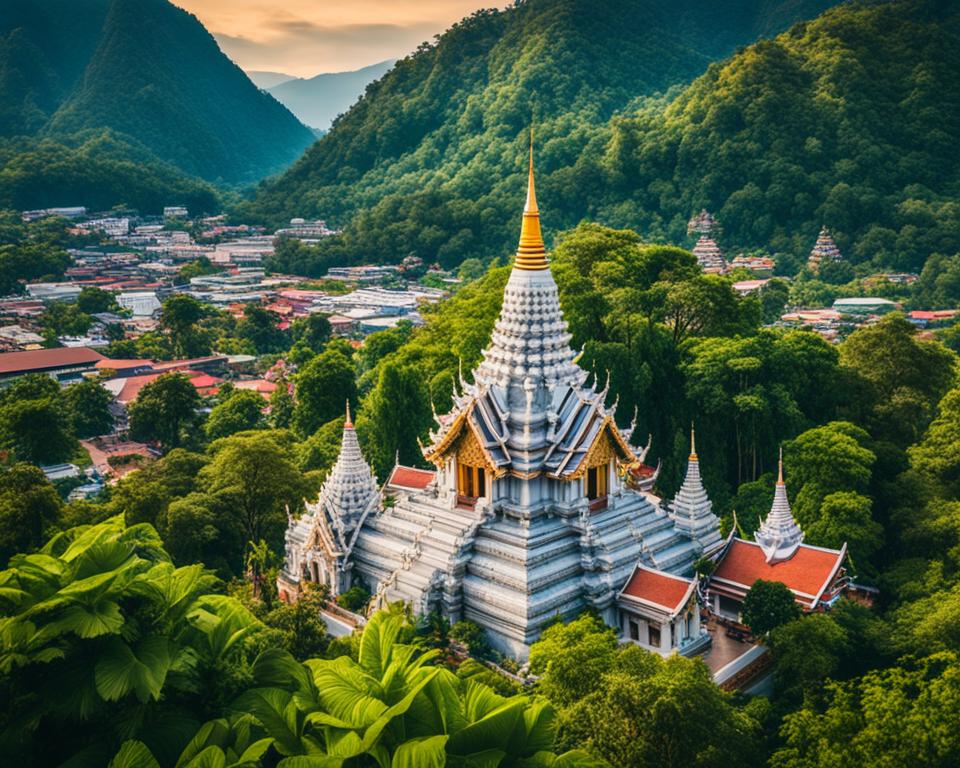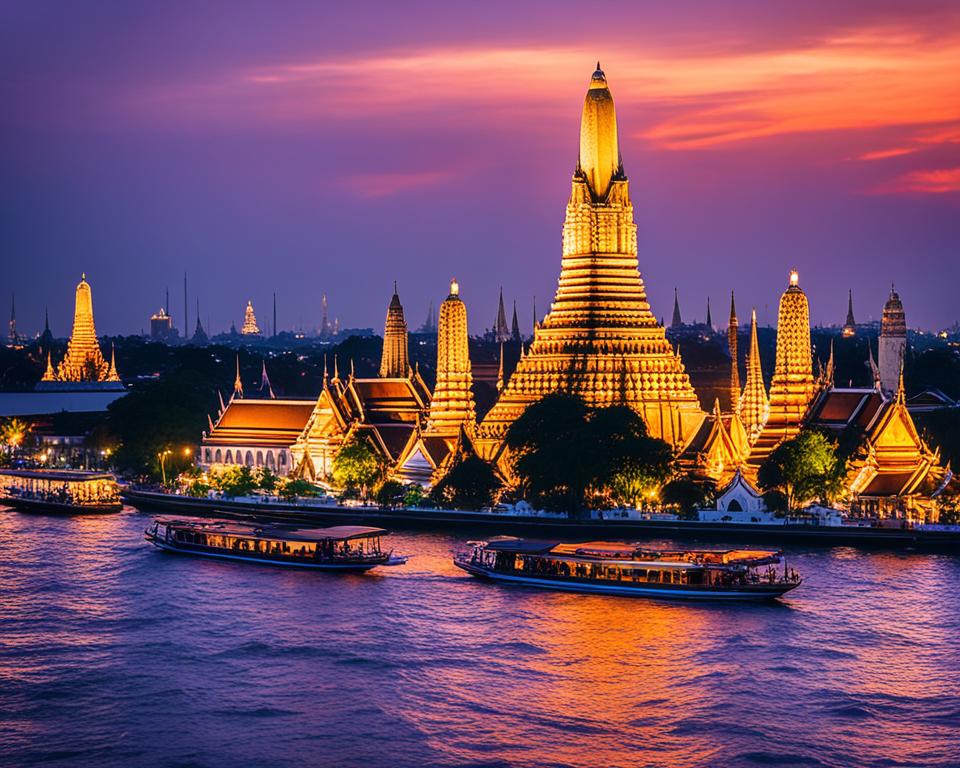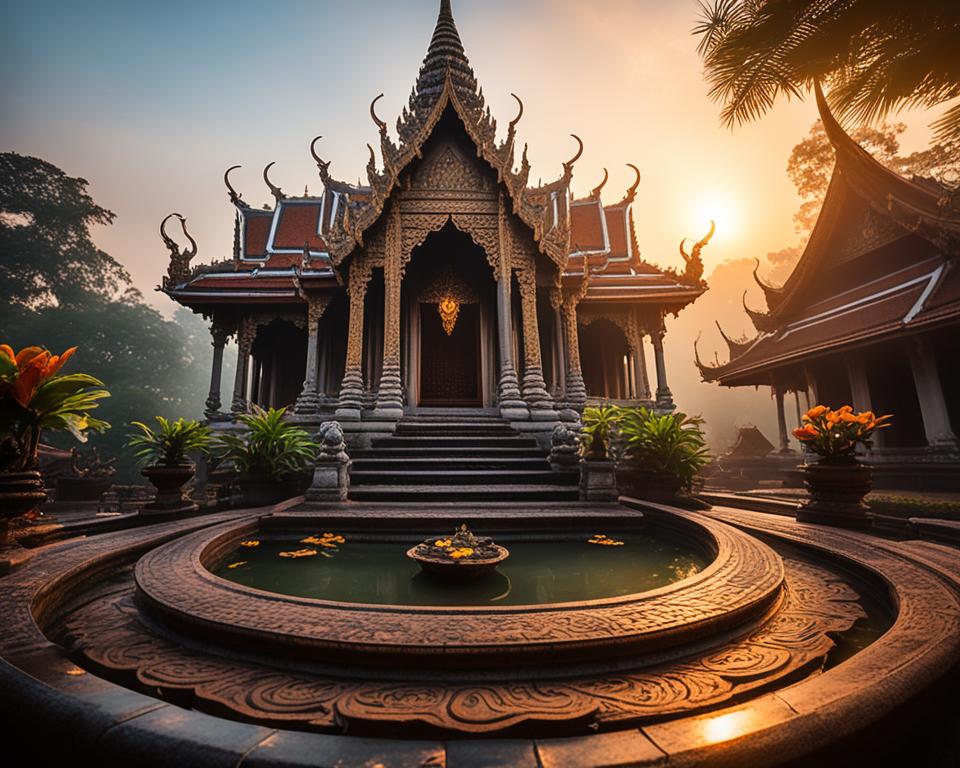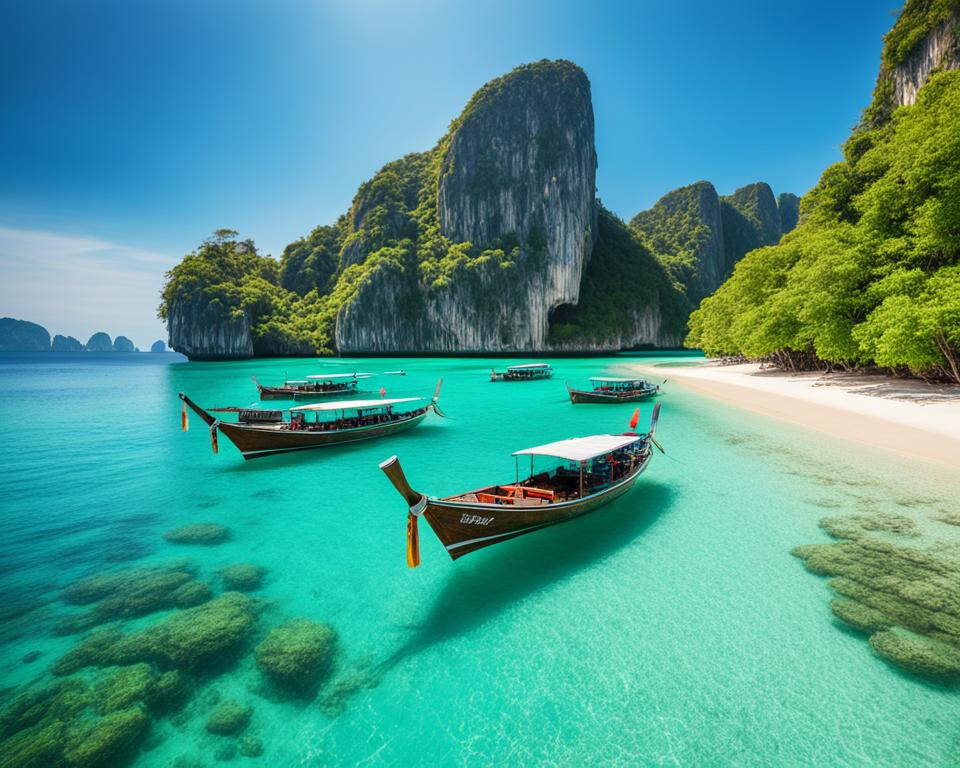Thailand is full of ancient and modern temples that catch the eye of visitors worldwide. These sacred places are key to the country’s culture. They show Thailand’s deep connection to Buddhism and how it shapes the Thai way of life. This guide explores the history, meaning, and top temple sites in Thailand. It aims to give you a deep understanding of how Buddhism influences the country.
Read more interesting information at ::lansdowne-moody
Exploring the Spiritual Heartland of Thailand
Thailand is known for its deep spiritual roots, showcased by its many temples. These sites tell the story of Buddhism’s lasting impact. They give us a window into Thai culture and beliefs. Whether you’re amazed by the grand temples or find peace in the hidden ones, a journey through Thailand’s spiritual side is unforgettable.
Thai temples are a big part of the country’s charm, drawing in people from all over. They’re not just beautiful, with golden spires and detailed artwork, but they hold deep spiritual significance. Visiting them takes you through time, showing how faith has always been central to Thai life.
“The temples of Thailand are not merely structures – they are living, breathing embodiments of the nation’s soul, inviting visitors to connect with the timeless traditions that have defined this enchanting land.” – Jane Doe, travel writer
Whether in bustling Bangkok or the calm of the north, Thailand’s spiritual side is full of surprises. It changes you, offering insights into faith and tradition. This journey not only touches your heart but also shows the spiritual soul of Thailand that few get to see.
Temples: The Cornerstone of Thai Culture
Thailand’s temples are the heart of the nation’s culture. They are more than places of worship. These stunning buildings are key to Thai life, beyond just their religious role.
The Role of Temples in Thai Society
Thailand’s temples are community centers. They offer education, care for the needy, and spiritual help. Here, people meditate, join in on religious events, and get advice from Thailand’s religious sites. Temples are also like schools, teaching about Thai temple architecture and local arts.
Architectural Styles and Influences
Thailand’s temples are a mix of different cultures. Indian, Khmer, and Thai styles come together in a unique way. From the impressive prang to the elegant chofah, each part tells a cultural story.
The variety of thailand buddhist temples shows a rich tradition. These places inspire and remind people of their strong faith. They are vital to Thailand’s cultural being.
Thailand’s Temple Hotspots
Thailand has a deep culture and spiritual tradition. Its temples are at the center of this amazing scene. In Bangkok, the capital city, you can see a lot of these beautiful temples. They are a key part of the thai tourist experience.
Bangkok: The City of Countless Temples
Bangkok is full of life and is Thailand’s capital city. It shines with many temples that amaze both local and foreign visitors. You can visit the famous Grand Palace and Wat Phra Kaew, or the calm Wat Arun and Wat Pho. These temples show off Thailand’s strong spiritual and cultural history.
On the Chao Phraya River, you’ll find the Grand Palace and Wat Phra Kaew. They are among Bangkok’s most famous temple sites. The Grand Palace was the royal family’s home for about 150 years. Wat Phra Kaew holds the Emerald Buddha, a very important Buddha image.
Across from these is the famous Wat Arun, or the “Temple of Dawn.” It’s known for its tall spires and detailed designs. It gives a great view of the city. Then there’s Wat Pho, the “Temple of the Reclining Buddha.” It has a giant Buddha statue that amazed all who see it with its size and beauty.
Bangkok is full of these amazing temples. Each one has a special design, story, and spirit. When people visit these places, they dive into the heart of thai culture and tradition.
The Grand Palace and Wat Phra Kaew
In the heart of Bangkok, you’ll find the Grand Palace and Wat Phra Kaew. They’re some of Thailand’s top sites. These places are rich in history and spiritual importance, making them magnets for global travelers.
The Grand Palace was the royal family’s home for over 150 years. It’s full of stunning buildings, with every detail showing off Thai art. The Wat Phra Kaew, known as the Temple of the Emerald Buddha, sits within the palace. It’s the most important Buddhist temple in the country.
Inside the Wat Phra Kaew is the Emerald Buddha, a small statue made from jade. This statue is very special to Thailand, so much so that only the Thai king looks after it. The temple itself is a beautiful example of Thai Buddhist architecture.
By visiting the Grand Palace and Wat Phra Kaew, you learn a lot about Thailand. You understand its cultural and spiritual roots better. These places are not just for tourists. They stand as symbols of Thailand’s rich cultural and spiritual history.
“The Grand Palace and Wat Phra Kaew are not just architectural wonders, but living embodiments of Thailand’s rich cultural heritage and spiritual identity.”
Ayutthaya: The Ancient Capital’s Iconic Temples
In the heart of Thailand, Ayutthaya reveals the country’s cultural riches. This ancient city was the capital and is now a UNESCO World Heritage Site. It features some of Thailand’s most impressive temples, showing its incredible temple design and rich history.
Wat Chaiwatthanaram: A UNESCO World Heritage Site
One of Ayutthaya’s standout temple sites is Wat Chaiwatthanaram. It’s a UNESCO World Heritage Site, showcasing brilliant Thai temple architecture. Built in the mid-17th century, it stands as a symbol of Ayutthaya’s prosperous past, being a center for trade, culture, and spirituality.
The temple mixes Khmer and Thai styles, seen in its impressive spires and detailed structures. Its central spire is surrounded by smaller temples, all well-maintained. This shows the splendor of ancient Thai temples.
“Wat Chaiwatthanaram is a true masterpiece of Thailand’s temple architecture, a testament to the country’s enduring cultural legacy.”
Wat Chaiwatthanaram also tells a story of Ayutthaya’s challenges. It was part of a larger group destroyed by the Burmese army in the 18th century. Despite this, it has been restored, becoming a symbol of Thailand’s strength in keeping its heritage alive.
Walking in its peaceful grounds, visitors connect with Ayutthaya’s past. They experience the history and beauty of its temples up close. For those interested in Thailand’s architecture and culture, this UNESCO site is a top pick.
Chiang Mai: Northern Thailand’s Temple Treasures
Chiang Mai is the cultural heart of Northern Thailand, filled with ancient temples. These temples highlight the area’s rich art and spiritual history. Once the capital of the Lanna Kingdom, this lively city dazzles with a variety of temples that have attracted visitors for ages.
The iconic Wat Phrathat Doi Suthep stands as a key Buddhist shrine atop Doi Suthep mountain. Reaching it means climbing a long stairway or driving up a scenic road. The temple’s golden spires and detailed carvings provide stunning views of Chiang Mai and beyond. Here, guests can tour the stunning buildings, join in on ceremonies, and observe the monks’ daily life.
Another top site, Wat Chedi Luang, once reached 300 feet high before an earthquake hit. Even with its changes, the site is remarkable for its huge scale and detailed carvings. It showcases the impressive Lanna style and holds significance as a past home of the Emerald Buddha.
Stepping into Chiang Mai’s temples is a full dive into culture. From the calm of Wat Suan Dok with its white chedis to Wat Phan Tao’s vivid murals and golden Buddhas, each stop is a view into Northern Thailand’s spiritual and artistic roots.
| Chiang Mai Temple | Architectural Highlights | Significance |
|---|---|---|
| Wat Phrathat Doi Suthep | Golden spires, intricate carvings | Revered Buddhist shrine with panoramic views |
| Wat Chedi Luang | Towering 14th-century monument, Lanna architectural style | Former home of the Emerald Buddha |
| Wat Suan Dok | Rows of white chedis, serene atmosphere | Showcases the spiritual and artistic traditions of Northern Thailand |
| Wat Phan Tao | Vibrant murals, golden Buddha statues | Offers a unique glimpse into the region’s cultural heritage |
Are you a devoted Buddhist, a fan of architecture, or just curious about Thailand’s culture? Visit Chiang Mai’s temples. They’re an essential stop for anyone touring Thailand’s temples.

“Chiang Mai’s temples are not just places of worship, but living embodiments of the region’s enduring spiritual and artistic traditions.”
Sukhothai: The Birthplace of Thai Architecture
Thailand’s ancient city, Sukhothai, sits proudly at its core. It was once the Thai kingdom’s capital. This city is known as the starting point of Thai architecture. Here, the unique style seen in Thailand’s temples and palaces today began.
Exploring the Sukhothai Historical Park
The Sukhothai Historical Park is a UNESCO World Heritage Site. It shows us an important time in Thailand’s history. The park covers 70 square kilometers and includes many ancient temple ruins. These ruins showcase the artistry and spiritual life of Sukhothai.
- Explore the iconic Wat Mahathat, a grand temple complex featuring towering Buddha statues and intricate stone carvings that exemplify the Sukhothai architectural style.
- Marvel at the serene Wat Si Chum, home to a colossal seated Buddha image that stands as a revered symbol of the Sukhothai kingdom.
- Discover the exquisite Wat Traphang Thong, a temple renowned for its elegant Khmer-influenced architecture and tranquil lotus ponds.
In the Sukhothai Historical Park, visitors can truly experience the richness of sukhothai temples and thai temple architecture. You can explore the well-preserved ruins and understand their deep spiritual and artistic meanings.
“Sukhothai is the birthplace of Thai architecture, where the distinctive style and artistry that would come to define the nation’s temples and palaces first emerged.”
| Temple | Architectural Highlights | Artistic Significance |
|---|---|---|
| Wat Mahathat | Towering Buddha statues, intricate stone carvings | Exemplifies the Sukhothai architectural style |
| Wat Si Chum | Colossal seated Buddha image | Revered symbol of the Sukhothai kingdom |
| Wat Traphang Thong | Elegant Khmer-influenced architecture, tranquil lotus ponds | Showcases the diverse cultural influences on Sukhothai architecture |
How Many Temples Are There in Thailand?
Thailand is famous for its many temples, with over 40,000 scattered across the land. This large number shows how important Buddhism is to the Thai people and their culture. It also highlights the country’s deep spiritual history.
Many things have led to so many temples in Thailand. In the past, building a temple showed how much wealth and good reputation a person had. This led to more and more temples being built.
Buddhism has a strong and old tradition in Thailand. Because of this, even small villages have their own temples. This is why there are so many temples in Thailand.
The Thailand Buddhist temples are at the heart of the country’s culture and spirituality. They are more than just places for worship. They also serve as places for learning and gathering with others.
In Thailand, you can find amazing temples in many places. From grand ones in Bangkok to ancient sites in Ayutthaya and peaceful temples in Chiang Mai. They all represent Thailand’s deep cultural roots and strong Buddhist influence.
“Thailand is a country of more than 40,000 temples, and each one is unique in its own way, reflecting the country’s diverse cultural, historical, and architectural influences.”
Iconic Temples You Shouldn’t Miss
Thailand is a captivating country known for its iconic temples with unique history. Two top temples to visit are Wat Arun, called the “Temple of Dawn,” and Wat Pho, with the giant Reclining Buddha.
Wat Arun: The Temple of Dawn
Wat Arun, or the Temple of Dawn, is famous for its stunning design. It stands by the Chao Phraya River in Bangkok. Its prangs are high spires covered in colorful porcelain, combining Thai and Khmer styles.
Visitors enjoy the peaceful vibe and can climb the central prang for a view. The temple’s name means “temple of the dawn” because it reflects the first light of day beautifully.
Wat Pho: The Temple of the Reclining Buddha
Wat Pho in Bangkok is home to a giant 46-meter Reclining Buddha. This statue showcases the deep spiritual importance of the temple and Thailand’s Buddhism.
Wat Pho is also known for its beautiful architecture, such as detailed murals and pagodas. There are many halls to explore and learn about Thai Buddhism.
Both Wat Arun and Wat Pho are must-see places in Thailand. They offer a rich glimpse into Thailand’s culture and spiritual life.

Etiquette and Dress Code for Temple Visits
Visiting Thailand’s temples is an amazing experience. But it’s important to follow the rules. Wearing the right clothing and showing the right behaviors are key. Doing so makes your visit better and shows respect for this special place.
Dress Code for Temple Visits
In Thailand, the thailand temple dress code is clear. You must cover up and dress modestly. Here’s what you should remember:
- Wear clothes that cover your shoulders and knees. No to sleeveless tops, shorts, and short skirts.
- Pick clothes that are light and breathable. It can get very hot in Thailand.
- Take off your shoes before going in. It’s a way to show the temple respect.
- Don’t wear anything revealing or too tight.
Etiquette for Temple Visits
Being respectful goes beyond how you dress. There are actions to be aware of at thailand temple etiquette:
- Keep your voice low and avoid anything that creates noise.
- Don’t touch or climb on any holy figures or objects.
- Stick to the paths provided and avoid the sacred areas.
- Don’t point your feet at the Buddha. This is seen as rude.
- Watch how you sit or stand. You should look respectful at all times.
Following these tips makes your temple visit respectful and memorable. It also shows you know how to honor Thailand’s culture and religion.
“Visiting a Thai temple is not just a sightseeing activity, but a chance to immerse yourself in the country’s rich cultural and spiritual heritage.”
Thailand’s Temple Tourism: A Spiritual Journey
Thailand’s ancient temples are a big attraction for visitors. They offer a chance to dive into the country’s spiritual and cultural traditions. Many travelers are drawn to these sites to see their amazing architecture and feel their sacred energy.
Sustainable Tourism and Preserving Cultural Heritage
The rise in thailand temple tourism calls for sustainable practices. These should help keep thailand’s ancient temples and the local communities that look after them safe. Initiatives for responsible tourism are working to keep the balance.
There are now strict rules for visitors at temple sites. These rules help protect the sites and teach visitors how to show respect. By knowing the right behavior and dress code, sustainable tourism thailand can grow without harming sacred spaces.
Local communities play a key role in keeping temple tourism sustainable. They help manage and explain the sites to visitors. This involvement means economic benefits are more fairly shared. It also ensures preservation work reflects the values of the Thai people.
Although thrilling for visitors, protecting temple sites is a crucial challenge. Striking a balance between showcasing culture and keeping the spirits of the temples alive is tough. Embracing sustainable tourism thailand can keep the country’s spiritual legacy alive. It invites travelers on a deep, enlightening journey through Thailand’s rich culture.
Conclusion
Thailand’s temples hold a key place in its culture and faith. They show a deep love for Buddhism and its effect on Thai life. We’ve covered many temples in Thailand, from famous ones in Bangkok and Ayutthaya to lesser-known spots in Chiang Mai and Sukhothai.
Learning about these places can make your trip more special. It will take you on a journey through the spirit of Thailand. The how many temples in thailand, thailand temples, and thailand buddhist temples are deeply tied to Thai culture. They let visitors experience and understand the long-lasting traditions of this amazing country.
If visiting these temples, it’s important to show respect. This includes following the right behavior and dress code. Doing this will help you truly appreciate Thailand’s spiritual past. It will make your connection with Thailand’s culture more meaningful and respectful.



